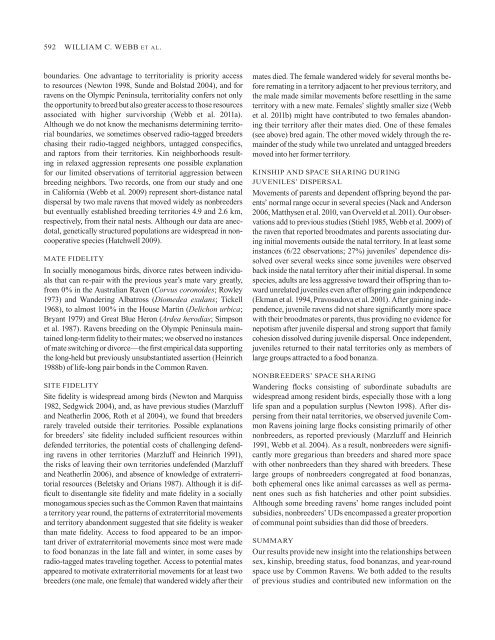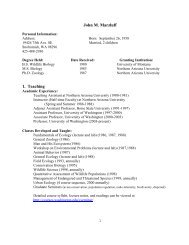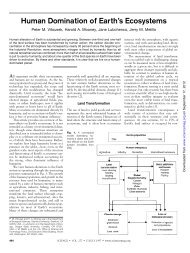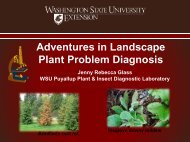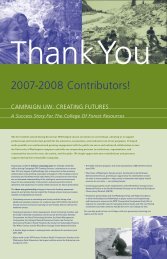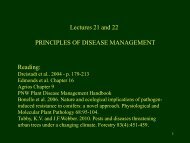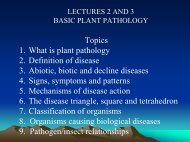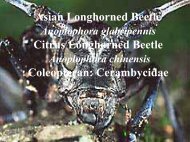DIFFERENCES IN SPACE USE by COMMON RAVENS IN ...
DIFFERENCES IN SPACE USE by COMMON RAVENS IN ...
DIFFERENCES IN SPACE USE by COMMON RAVENS IN ...
- No tags were found...
Create successful ePaper yourself
Turn your PDF publications into a flip-book with our unique Google optimized e-Paper software.
592 William C. Webb et al.boundaries. One advantage to territoriality is priority accessto resources (Newton 1998, Sunde and Bolstad 2004), and forravens on the Olympic Peninsula, territoriality confers not onlythe opportunity to breed but also greater access to those resourcesassociated with higher survivorship (Webb et al. 2011a).Although we do not know the mechanisms determining territorialboundaries, we sometimes observed radio-tagged breederschasing their radio-tagged neighbors, untagged conspecifics,and raptors from their territories. Kin neighborhoods resultingin relaxed aggression represents one possible explanationfor our limited observations of territorial aggression betweenbreeding neighbors. Two records, one from our study and onein California (Webb et al. 2009) represent short-distance nataldispersal <strong>by</strong> two male ravens that moved widely as nonbreedersbut eventually established breeding territories 4.9 and 2.6 km,respectively, from their natal nests. Although our data are anecdotal,genetically structured populations are widespread in noncooperativespecies (Hatchwell 2009).Mate fidelityIn socially monogamous birds, divorce rates between individualsthat can re-pair with the previous year’s mate vary greatly,from 0% in the Australian Raven (Corvus coronoides; Rowley1973) and Wandering Albatross (Diomedea exulans; Tickell1968), to almost 100% in the House Martin (Delichon urbica;Bryant 1979) and Great Blue Heron (Ardea herodias; Simpsonet al. 1987). Ravens breeding on the Olympic Peninsula maintainedlong-term fidelity to their mates; we observed no instancesof mate switching or divorce—the first empirical data supportingthe long-held but previously unsubstantiated assertion (Heinrich1988b) of life-long pair bonds in the Common Raven.Site fidelitySite fidelity is widespread among birds (Newton and Marquiss1982, Sedgwick 2004), and, as have previous studies (Marzluffand Neatherlin 2006, Roth et al 2004), we found that breedersrarely traveled outside their territories. Possible explanationsfor breeders’ site fidelity included sufficient resources withindefended territories, the potential costs of challenging defendingravens in other territories (Marzluff and Heinrich 1991),the risks of leaving their own territories undefended (Marzluffand Neatherlin 2006), and absence of knowledge of extraterritorialresources (Beletsky and Orians 1987). Although it is difficultto disentangle site fidelity and mate fidelity in a sociallymonogamous species such as the Common Raven that maintainsa territory year round, the patterns of extraterritorial movementsand territory abandonment suggested that site fidelity is weakerthan mate fidelity. Access to food appeared to be an importantdriver of extraterritorial movements since most were madeto food bonanzas in the late fall and winter, in some cases <strong>by</strong>radio-tagged mates traveling together. Access to potential matesappeared to motivate extraterritorial movements for at least twobreeders (one male, one female) that wandered widely after theirmates died. The female wandered widely for several months beforeremating in a territory adjacent to her previous territory, andthe male made similar movements before resettling in the sameterritory with a new mate. Females’ slightly smaller size (Webbet al. 2011b) might have contributed to two females abandoningtheir territory after their mates died. One of these females(see above) bred again. The other moved widely through the remainderof the study while two unrelated and untagged breedersmoved into her former territory.Kinship and space sharing duringjuveniles’ dispersalMovements of parents and dependent offspring beyond the parents’normal range occur in several species (Nack and Anderson2006, Matthysen et al. 2010, van Overveld et al. 2011). Our observationsadd to previous studies (Stiehl 1985, Webb et al. 2009) ofthe raven that reported broodmates and parents associating duringinitial movements outside the natal territory. In at least someinstances (6/22 observations; 27%) juveniles’ dependence dissolvedover several weeks since some juveniles were observedback inside the natal territory after their initial dispersal. In somespecies, adults are less aggressive toward their offspring than towardunrelated juveniles even after offspring gain independence(Ekman et al. 1994, Pravosudova et al. 2001). After gaining independence,juvenile ravens did not share significantly more spacewith their broodmates or parents, thus providing no evidence fornepotism after juvenile dispersal and strong support that familycohesion dissolved during juvenile dispersal. Once independent,juveniles returned to their natal territories only as members oflarge groups attracted to a food bonanza.Nonbreeders’ space sharingWandering flocks consisting of subordinate subadults arewidespread among resident birds, especially those with a longlife span and a population surplus (Newton 1998). After dispersingfrom their natal territories, we observed juvenile CommonRavens joining large flocks consisting primarily of othernonbreeders, as reported previously (Marzluff and Heinrich1991, Webb et al. 2004). As a result, nonbreeders were significantlymore gregarious than breeders and shared more spacewith other nonbreeders than they shared with breeders. Theselarge groups of nonbreeders congregated at food bonanzas,both ephemeral ones like animal carcasses as well as permanentones such as fish hatcheries and other point subsidies.Although some breeding ravens’ home ranges included pointsubsidies, nonbreeders’ UDs encompassed a greater proportionof communal point subsidies than did those of breeders.SummaryOur results provide new insight into the relationships betweensex, kinship, breeding status, food bonanzas, and year-roundspace use <strong>by</strong> Common Ravens. We both added to the resultsof previous studies and contributed new information on the


